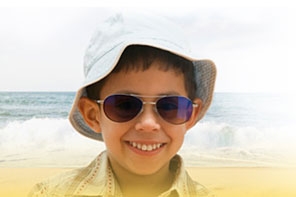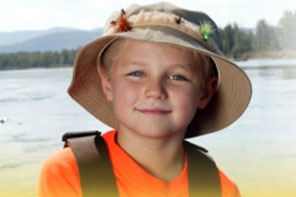Overview
Help patients develop good habits early
|
|
UV radiation is a preventable threat to eye health. Because damage to the eyes from prolonged UV exposure is cumulative and long-term, early ocular protection is vital.
|
It is a sensible approach to recommend UV-blocking measures to children and teenagers: good quality UV-blocking wrap-around sunglasses, UV-blocking contact lenses and a wide brimmed hat.
1. Young RW. The family of sunlight-related eye diseases. Optom Vis Sci 1994;71(2):125-44.
2. Bova LM, Sweeney MHJ, Jamie JF, Truscott RJW. Major changes in human ocular UV protection with age. Invest Ophthalmol Vis Sci 2001;42(1):200-5.
3. Sasaki H. UV exposure to eyes greater in morning, late afternoon. Proc. 111th Ann. Meeting, Japanese Ophthalmologic Soc., Osaka, Japan, April, 2007.
Always rely on your professional expertise to judge each young patient's maturity level and the degree of parental support before deciding whether a child is a good candidate for contact lens wear and can follow your recommended wear and care instructions.
Susceptibility to UV exposure
UV exposure is a particular threat to children
|
Those at risk include children with:
|
 |
The effects of ocular exposure to UV are cumulative, with around a quarter of a lifetime's UV dose occurring by the age of 18.4 With larger pupils and clearer lenses, children are particularly vulnerable to UV exposure, receiving three times the annual UV dose as adults.1,2 And, because they spend more time outdoors and have increased exposure to reflective surfaces such as sand, pavement, water and snow, children's risk of ocular UV damage is intensified.1,2
Ozone depletion, longer life expectancies and more time outdoors can all contribute to the threat of overexposure to UV radiation. These factors, as well as poor compliance with UV-blocking measures among the general population all present opportunities for you to offer your young patients potentially sight-saving educational information about the risk of prolonged UV exposure.
Always rely on your professional expertise to judge each young patient's maturity level and the degree of parental support before deciding whether a child is a good candidate for contact lens wear and can follow your recommended wear and care instructions.
1. Young S, Sands J. Sun and the eye: prevention and detection of light-induced disease. Clin Dermatol 1998;16(4):477-85.
2. Werner JS. Children's sunglasses: caveat emptor. Opt Vision Sci 1991;68:318-20.
3. Maddock J et al. Use of Sunglasses in Public Outdoor Recreation Settings in Honolulu, Hawaii. Optom Vis Sci, 2009, 86 (2): 165–166.
4. Godar DE, Urbach F, Gasparro FP, et al. UV doses of young adults. Photochem Photobiol 2003;77:453–457.
Early ocular protection
All-around protection from UV exposureMost parents wouldn't consider letting their children spend an extended period of time in the sun without sunscreen; yet only 3% of children regularly wear sunglasses.1 Because ocular damage from prolonged UV exposure is cumulative and long-term, it is vital to safeguard children's eyes from this threat as vigilantly as we do their skin.
The benefits of providing UV education to your young patients and their parents are significant:
Ocular protection from UV exposure includes:
|
|
You can help young patients and their families by emphasising the importance of protection from UV exposure. By educating children, teens and their parents, good eye health can become something every family member strives for and encourages in others. The earlier ocular protection begins, the more your young patients will benefit – growing into adults inclined to instil those same good habits in their children.
Always rely on your professional expertise to judge each young patient's maturity level and the degree of parental support before deciding whether a child is a good candidate for contact lens wear and can follow your recommended wear and care instructions.
1. Maddock J et al. Use of Sunglasses in Public Outdoor Recreation Settings in Honolulu, Hawaii. Optom Vis Sci, 2009, 86 (2): 165–166.
Ocular health measures
What children need for optimal protection
|
There are a number of ways to enhance protection from UV exposure for children and teens:
|
|
Read more about the UV problem and the ACUVUE® initiative
*All ACUVUE® Brand Contact Lenses have Class 1 or Class 2 UV-blocking to help provide protection against transmission of harmful UV radiation to the cornea and into the eye. UV-absorbing contact lenses are NOT substitutes for protective UV-absorbing eyewear such as UV-absorbing goggles or sunglasses because they do not completely cover the eye and surrounding area. UV transmission measured with -1.00D lens. JJVC Data on file 2012.
1. Sasaki H. UV exposure to eyes greater in morning, late afternoon. Proc. 111th Ann. Meeting, Japanese Ophthalmologic Soc., Osaka, Japan, April, 2007.
Rely on your professional expertise to judge each young patient's maturity level and the degree of parental support before deciding whether a child is a good candidate for contact lens wear and can follow your recommended wear and care instructions.





